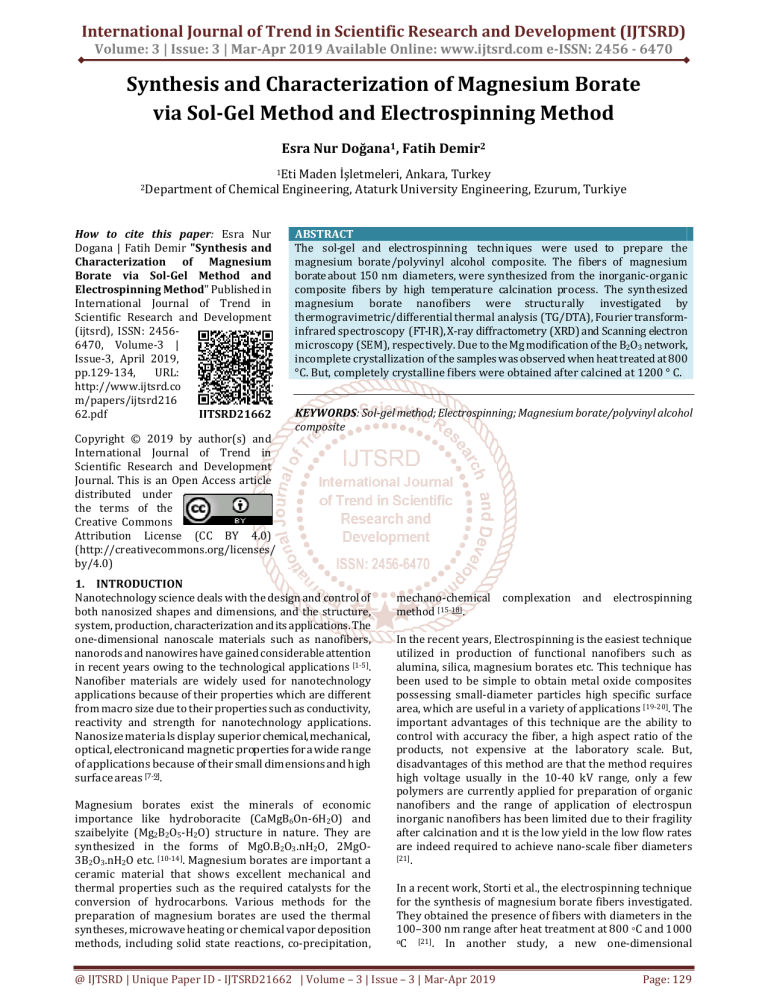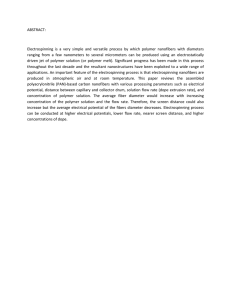
International Journal of Trend in Scientific Research and Development (IJTSRD)
Volume: 3 | Issue: 3 | Mar-Apr 2019 Available Online: www.ijtsrd.com e-ISSN: 2456 - 6470
Synthesis and Characterization of Magnesium Borate
via Sol-Gel Method and Electrospinning Method
Esra Nur Doğana1, Fatih Demir2
1Eti
2Department
Maden İşletmeleri, Ankara, Turkey
of Chemical Engineering, Ataturk University Engineering, Ezurum, Turkiye
How to cite this paper: Esra Nur
Dogana | Fatih Demir "Synthesis and
Characterization of Magnesium
Borate via Sol-Gel Method and
Electrospinning Method" Published in
International Journal of Trend in
Scientific Research and Development
(ijtsrd), ISSN: 24566470, Volume-3 |
Issue-3, April 2019,
pp.129-134,
URL:
http://www.ijtsrd.co
m/papers/ijtsrd216
62.pdf
IJTSRD21662
ABSTRACT
The sol-gel and electrospinning techniques were used to prepare the
magnesium borate/polyvinyl alcohol composite. The fibers of magnesium
borate about 150 nm diameters, were synthesized from the inorganic-organic
composite fibers by high temperature calcination process. The synthesized
magnesium borate nanofibers were structurally investigated by
thermogravimetric/differential thermal analysis (TG/DTA), Fourier transforminfrared spectroscopy (FT-IR), X-ray diffractometry (XRD) and Scanning electron
microscopy (SEM), respectively. Due to the Mg modification of the B2O3 network,
incomplete crystallization of the samples was observed when heat treated at 800
°C. But, completely crystalline fibers were obtained after calcined at 1200 ° C.
KEYWORDS: Sol-gel method; Electrospinning; Magnesium borate/polyvinyl alcohol
composite
Copyright © 2019 by author(s) and
International Journal of Trend in
Scientific Research and Development
Journal. This is an Open Access article
distributed under
the terms of the
Creative Commons
Attribution License (CC BY 4.0)
(http://creativecommons.org/licenses/
by/4.0)
1. INTRODUCTION
Nanotechnology science deals with the design and control of
both nanosized shapes and dimensions, and the structure,
system, production, characterization and its applications. The
one-dimensional nanoscale materials such as nanofibers,
nanorods and nanowires have gained considerable attention
in recent years owing to the technological applications [1-5].
Nanofiber materials are widely used for nanotechnology
applications because of their properties which are different
from macro size due to their properties such as conductivity,
reactivity and strength for nanotechnology applications.
Nanosize materials display superior chemical, mechanical,
optical, electronicand magnetic properties for a wide range
of applications because of their small dimensions and high
surface areas [7-9].
Magnesium borates exist the minerals of economic
importance like hydroboracite (CaMgB6On-6H2O) and
szaibelyite (Mg2B2O5-H2O) structure in nature. They are
synthesized in the forms of MgO.B2O3.nH2O, 2MgO3B2O3.nH2O etc. [10-14]. Magnesium borates are important a
ceramic material that shows excellent mechanical and
thermal properties such as the required catalysts for the
conversion of hydrocarbons. Various methods for the
preparation of magnesium borates are used the thermal
syntheses, microwave heating or chemical vapor deposition
methods, including solid state reactions, co-precipitation,
mechano-chemical
method [15-18].
complexation
and
electrospinning
In the recent years, Electrospinning is the easiest technique
utilized in production of functional nanofibers such as
alumina, silica, magnesium borates etc. This technique has
been used to be simple to obtain metal oxide composites
possessing small-diameter particles high specific surface
area, which are useful in a variety of applications [19-20]. The
important advantages of this technique are the ability to
control with accuracy the fiber, a high aspect ratio of the
products, not expensive at the laboratory scale. But,
disadvantages of this method are that the method requires
high voltage usually in the 10-40 kV range, only a few
polymers are currently applied for preparation of organic
nanofibers and the range of application of electrospun
inorganic nanofibers has been limited due to their fragility
after calcination and ıt is the low yield in the low flow rates
are indeed required to achieve nano-scale fiber diameters
[21].
In a recent work, Storti et al., the electrospinning technique
for the synthesis of magnesium borate fibers investigated.
They obtained the presence of fibers with diameters in the
100–300 nm range after heat treatment at 800 ◦C and 1000
oC [21]. In another study, a new one-dimensional
@ IJTSRD | Unique Paper ID - IJTSRD21662 | Volume – 3 | Issue – 3 | Mar-Apr 2019
Page: 129
International Journal of Trend in Scientific Research and Development (IJTSRD) @ www.ijtsrd.com eISSN: 2456-6470
nanostructure, Mg3B2O6 nanobelts were synthesized by
thermal treating of the mixed powders of boron and
magnesium oxide in the presence of H2O vapor. Magnesium
borate nanobelts were prepared by heating mixed powders
of boron and MgO under flowing Ar/H2O gases at 1100 oC,
and typical widths of the nanobelts were obtained in the
range of 100-300 nm [22]. Sevim et al. Nanofibers of PVA
/nickel nitrate/silica/alümina izopropoxide/boric acid
composite prepared by using sol-gel processing and
electrospinning technique. As a result, By high temperature
calcinations of the above precursor fibers, nanofibers of
NiO/Al2O3/B2O3/SiO2 composite with diameters about 500
nm were successfully obtained [23].
In this paper, we present the production of pure magnesium
borate nanofibers by the calcination of inorganic composite
fibers obtained through electrospinning by sol-gel method.
We report a production nanofibers and characterization of
magnesium borate nanofibers. This study may be useful to
investigate the possibilities of commercial application of the
magnesium borate nanofibers in the coming years.
2. EXPERİMENTAL
The boron source of boric acid (H3BO3) is retrieved from
Etibank Emet Boron and Acid Factory in Turkey. The
electrospinning sol-gel solutions consisted of Mg(NO3)2
(Merck, >99%), hydrochloric acid (Sigma-Aldrich, 37%),
polyvinyl alcohol (PVA Mw = 240.000 g/mol, SigmaAldrich), ethanol (Sigma-Aldrich, >99%) and distilled
water. The aqueous solution of PVA was firstly prepared
by dissolving 10 g PVA powder in 100 ml distilled water
stirring for 2 h at 80 °C. Then it was cooled to room
temperature by stirring continued for 12 h. The gel solution
was prepared by mixing ethanol, concentrated HCl and
distilled water all together. The mixed solution was kept
with magnetic stirring for 2h in a room temperature. In
another bowl, PVA and boric acid were mixed with
magnesium nitrate. Then the other solutions were added
into the prepared PVA solution under stirring at a slow
speed in a particular order. The pH of the medium must be
below 2 because of it is prevented peptization during the
formation of the sol-gel. Then the gel composite was filled in
a plastic syringe (10 ml) and placed into syringe pump. A
copper wire connected to a high-voltage device was attached
to the plastic syringe by adjusting the angle between the
fixing bar and the capillary tip. A voltage 15 kV and the feed
0.3 ml/h rate was applied to the gel. The fibers were
accumulated on the aluminum foil. Measured fiber diameters
were obtained on solution %10 PVA, distance 15 cm and
voltage 15 kV in ideal working conditions. The fibers
occurred were firstly dried at 110 °C for 2 h and then
calcined in air at 800 °C and 1200 °C, standing at a heating
rate of 2 °C /min for 2 h, respectively. The magnesium borate
nanofibers were obtained.
DTA and TG were operated on a NETZSCH STA 449F3
thermo-processing in air at a temperature range of 0–1200
°C and thermal experiments were treated with a certain
sample weight. The sample was established a platinum
crucible and its dehydration was recorded at the 10 °C min-1
of constant heating rate under nitrogen atmosphere with 20
min of a purge time and 25 ml/min of a flow rate.
The absorbance spectra of deposited nanofibers of
Magnesium borate composite on Au Plates were measured
using a different angle reflection equipment in conjunction
with a Perkin–Elmer Spectrum One FTIR spectroscopy in the
range of 4000-400 cm-1 at room temperature. All the
measurements were obtained with a resolution of 2 cm-1 and
an average of 100 scans. SEM (Philips XL30 SFEG) was
investigated the morphologies of the samples. SEM images
were recorded using a Leco 1430 V.P. SEM instrument with
12–24 kV accelerating voltage and 130–150 pA beam
current.
XRD (The thermobalance measured mass to 0.001mg, with
an accuracy of ±1%.) experiments for nanofilms on
nanofibers of Magnesium borate composite were measured
with a Rigaku Advance Powder X-ray Diffractometer device
using Cu Kα radiation (λ = 1.5405 Å), operating at 30 mA and
30 kV about a 2h range of 20–60o. The XRD phases were
identified with the help of the Joint Committee on Powder
Diffraction Standards-International Center for Diffraction
Data (JCPDS-ICDD).
3. RESULTS AND DISCUSSION
3.1. Differential Thermal and Thermogravimetric
Analysis (DTA/TG):
The TG and DTA results are shown in Fig. 1. As seen
from the DTA curve, two endothermic peaks, related with
the loss of absorbed water, dehydration on the side chain of
polymer and degradation of remaining alkyl groups, are
around 165.4 and 283.3 °C. In addition to those, the
organic groups and PVA were utterly removed at 400-500
°C. As seen TG curve, the loss of sample weight was
obtained about 80%. Above the temperature of 600 °C
related to the formation of pure inorganic oxide in
crystalline form, there is not seen any loss of weight.
Equations (1), (2) and (3) describe the room temperature
and thermal process, respectively;
7Mg (NO3)2 + 4H3BO3 + 14NaOH → Mg7B4O13·7H2O(s) +
14NaNO3 + 6H2O
(1)
Mg7B4O13·7H2O(s) + 3H3BO3→7MgBO2 (OH)(s) + 8H2O (2)
2MgBO2 (OH)(s)→Mg2B2O5 (s) + H2O
@ IJTSRD | Unique Paper ID - IJTSRD21662 | Volume – 3 | Issue – 3 | Mar-Apr 2019
(3)
Page: 130
International Journal of Trend in Scientific Research and Development (IJTSRD) @ www.ijtsrd.com eISSN: 2456-6470
Fig.1. TG-DTA thermogravimeter for the composite fibers of the Mg2B2O5/PVA in nitrogen atmosphere
3.2. Fourier Transform Infrared (FT-IR):
Fig. 2-3 shows the FT-IR spectra the Mg2B2O5/PVA fibers at room temperature, and for those sintered at temperatures of 800°C
and 1200°C, respectively. In Figures, the Mg2B2O5/PVA fibers show a broad peak at 3272 cm-1 corresponding to H–OH stretch;
and the characteristic absorption peaks at about 2916, 2624, 2021, 1655, 1325 and 1086 corresponding to vibration bands of
C−C, C−H, O−H, C−O, respectively. The BO3 in 826 cm-1 and 1412 cm-1 peaks, BO4 in 914 cm-1 and 1086 cm-1 peaks and BOH in
1325 cm-1 peak is indicated the structure of bonds in Fig.2-3. In sintering, between 800 °C and 1200 °C, all peaks forming from
water and organic structures almost disappeared. In addition, at these temperatures clear new peak groups, which may be
associated to the formation of inorganic phase crystalline, appears at 800-1650 cm-1. Thus, it may be received that these peaks
over and over each other.
Fig.2. FT-IR spectrum analysis for the composite fibers of the Mg2B2O5/PVA at 800 °C
@ IJTSRD | Unique Paper ID - IJTSRD21662 | Volume – 3 | Issue – 3 | Mar-Apr 2019
Page: 131
International Journal of Trend in Scientific Research and Development (IJTSRD) @ www.ijtsrd.com eISSN: 2456-6470
Fig.3. FT-IR spectrum analysis for the composite fibers of the Mg2B2O5/PVA at 1200 °C
3.3. X-ray Diffraction (XRD):
Fig. 4 and 5 shows the XRD pattern of as-prepared Mg2B2O5 nanofibers in calcination temperature at 800 and 1200 °C. All of the
diffraction peaks can be indexed as a triclinic Mg2B2O5 structure (JCPDS Card No: 83-0625). The characteristic peaks at 31.78,
35.38 and 45.2 in the spectrum can be readily corresponded to [200], [-220], [0-21], [-3 2 0], [-131] and [141] crystal planes of
Mg2B2O5. The image diffraction peaks recommend that the patterns could be well crystallized. Mg2B2O5 nanofibers with high
purity were obtained.
Fig.4. XRD pattern of Mg2B2O5 nanofibers at 800 °C.
@ IJTSRD | Unique Paper ID - IJTSRD21662 | Volume – 3 | Issue – 3 | Mar-Apr 2019
Page: 132
International Journal of Trend in Scientific Research and Development (IJTSRD) @ www.ijtsrd.com eISSN: 2456-6470
Fig.5. XRD pattern of Mg2B2O5 nanofibers at 1200 °C.
3.4. Scanning electron microscopy (SEM):
Fig. 6-8 show before calcined, 800 °C and 1200 °C calcined,
respectively. It was used ImageJ programming for particle
diameters. SEM appearances of the magnesium borate
before calcined are shown an irregular structure which
beaded in Fig. 6. High-magnification SEM image shown in
Fig. 7-8 presents that the product displays one-dimensional
nanostructures which was consisted of a regular quantity of
nanofibers. The plain nanofibers formed a web-like
appearance and having a uniform diameter with an average
of about 150 nm.
Fig.8. 1200 °C SEM image of synthesized nanofibers
Fig.6. SEM image of synthesized nanofibers before
calcined
4. CONCLUSIONS
Mg2B2O5/PVA fibers were prepared by the sol-gel process
and fabricated by electrospinning. This method is simple and
effective to produce nanofibers of inorganic oxide composite.
On the basis of XRD results of products at different stages,
indicate that the formation of Mg2B2O5 nanofibers. The SEM
investigation unclosed that the diameters of these nanofibers
became more uniform after calcination. The TGA
thermograms indicated that the thermal stability of the
nanofibers was improved, which demonstrated the
formation of secondary bonds. In addition, the NMR
thermograms at 800-1650 cm-1 appears new peak groups,
which may be associated to the formation of inorganic phase
crystalline at these temperatures. The best yield and the
uniform morphology of Mg2B2O5 nanofibers can be obtained
from high temperature calcination at 800 °C and 1200 °C
with diameters down to 100-200 nm.
References
[1] L. Kumari, W. Z. Li, S. Kulkarni, K. H. Wu, W. Chen, C. L.
Wang, C. H. Vannoy, R. M. Leblanc, Effect of Surfactants
on the Structure and Morphology of Magnesium Borate
Hydroxide
Nanowhiskers
Synthesized
by
Hydrothermal Route. Nanoscale Research Letters, 5
(2010) 149-157.
Fig.7. 800 °C SEM image of synthesized nanofibers
@ IJTSRD | Unique Paper ID - IJTSRD21662 | Volume – 3 | Issue – 3 | Mar-Apr 2019
Page: 133
International Journal of Trend in Scientific Research and Development (IJTSRD) @ www.ijtsrd.com eISSN: 2456-6470
[2] W. C. Zhu, G. D. Li, Q. Zhang, L. Xiang, S. L. Zhu,
Hydrothermal mass production of MgBO2(OH)
nanowhiskers and subsequent thermal conversion to
Mg2B2O5 nanorods for biaxially oriented polypropylene
resins reinforcement. Powder Technology, 203 (2010)
265-271.
[3] S. Li, D. P. Xu, H. Z. Shen, J. Zhou, Y. Fan, Synthesis and
Raman
properties
of
magnesium
borate
micro/nanorods. Materials Research Bulletin, 47
(2012) 3650-3653.
[4] X. Y. Tao, X. D. Li, Catalyst-free synthesis, structural,
and mechanical characterization of twinned Mg2B2O5
nanowires. Nano Letters, 8 (2008) 505-510.
improvement in the thermal conversion of the
hydrothermal synthesized MgBO2(OH) nanowhiskers
to Mg2B2O5 nanowhiskers. Journal of Crystal Growth
310 (2008) 4262-4267.
[14] Y. Z. Jia, S. Y. Gao, S. P. Xia, J. Li, FT-IR spectroscopy of
supersaturated aqueous solutions of magnesium
borate. Spectrochimica Acta Part a-Molecular and
Biomolecular Spectroscopy, 56 (2000) 1291-1297.
[15] S. Li, X. Fang, J. Leng, H. Z. Shen, Y. Fan, D. P. Xu: A new
route for the synthesis of Mg2B2O5 nanorods by
mechano-chemical and sintering process. Materials
Letters, 64 (2010) 151-153.
[5] U. Dosler, M. M. Krzmanc, D. Suvorov, The synthesis
and microwave dielectric properties of Mg3B2O6 and
Mg2B2O5 ceramics. Journal of the European Ceramic
Society, 30 (2010) 413-418.
[16] A.S. Kipcak, M. Yildirim, S. Aydin Yuksel, E. Moroydor
Derun, S. Piskin, Thesynthesis and physical properties
of magnesium borate mineral of admontite synthesized
from sodium borates, Adv. Mater. Sci. Eng. 2014 (2014)
1–9.
[6] Z. S. Hu, R. Lai, F. Lou, L. G. Wang, Z. L. Chen, G. X. Chen,
J. X. Dong, Preparation and tribological properties of
nanometer magnesium borate as lubricating oil
additive. Wear, 252 (2002) 370-374.
[17] D.H. Reneker, A.L. Yarin, H. Fong, S. Koombhongse,
Bending instability of elec-trically charged liquid jets of
polymer solutions in electrospinning, J. Appl. Phys., 87
(2000) 4531.
[7] M. Koruk, I. Girgin, Synthesis of magnesium borates
using sodium borate and magnesium sulfate. Journal of
Non-Crystalline Solids, 355 (2009) 965-969.
[18] X. Shi, W. Zhou, D. Ma, Q. Ma, D. Bridges, Y. Ma, et al.,
Electrospinning of nanofibers and their applications for
energy devices, J. Nanomater. 4 (2015) 1–20.
[8] Y. Zeng, H. B. Yang, W. Y. Fu, L Qiao, L. X. Chang, J. J.
Chen, H. Y. Zhu, M. H. Li, GT Zou, Synthesis of
magnesium borate (Mg2B2O5) nanowires, growth
mechanism and their lubricating properties. Materials
Research Bulletin, 43 (2008) 2239-2247.
[19] F. Sevim, E. Sevimli, Structure Investigations of
NiO/Al2O3/B2O3/SiO2 Composite Based on PVA Using
Sol-Gel Processing and the Electrospinning Technique.
Asian Journal of Chemistry, 26 (2014) 2293-2295.
[9] Z. H. Liang, S. Li, P. Z. Lu, C. M. Fan, Electrochemical
synthesis of magnesium borate whisker. Journal of
Applied Electrochemistry, 41 (2011) 961-963.
[10] A. F. Qasrawi, T. S. Kayed, A.Mergen, M. Gürü, Synthesis
and characterization of Mg2B2O5. Materials Research
Bulletin, 40 (2005) 583-589.
[11] S. H. Chen, P. P. Jin, G. Schumacher, N. Wanderka,
Microstructure and interface characterization of a cast
Mg2B2O5 whisker reinforced AZ91D magnesium alloy
composite. Composites Science and Technology 70
(2010) 123-129.
[12] E. M. Elssfah, A. Elsanousi, J. Zhang, H. S. Song, C. Tang:
Synthesis of magnesium borate nanorods. Materials
Letters 61 (2007) 4358-4361.
[13] W. C. Zhu, L. Xiang, Q. Zhang, X. Y. Zhang, LH u, S.L. Zhu,
Morphology
preservation
and
crystallinity
[20] A. L. Yarin, S. Koombhongse, D. H. Reneker, Taylor cone
and jetting from liquid droplets in electrospinning of
nanofibers, J. Appl. Phys. 90 (2001) 4836.
[21] E. Storti, M. Roso, M. Modesti, C. G. Aneziris, P.
Colombo, Preparation and morphology of magnesium
borate fibers via electrospinning. Journal of the
European Ceramic Society, 36 (2016) 2593-2599.
[22] J. Zhang, Z. Li, B. Zhang, Formation and structure of
single crystalline magnesiumborate (Mg3B2O6)
nanobelts, Mater. Chem. Phys., 98 (2006) 195–197.
[23] F. Sevim, E. Sevimli, F. Demir, T. Çalban, The Effect of
Parameters on Productions of NiO/Al2O3/B2O3/SiO2
Composite Nanofibers by Using Sol-Gel Processing and
Electrospinning. World Academy of Science,
Engineering and Technology, International Journal of
Environmental, Chemical, Ecological, Geological and
Geophysical Engineering, 9 (2015) 381-384.
@ IJTSRD | Unique Paper ID - IJTSRD21662 | Volume – 3 | Issue – 3 | Mar-Apr 2019
Page: 134




